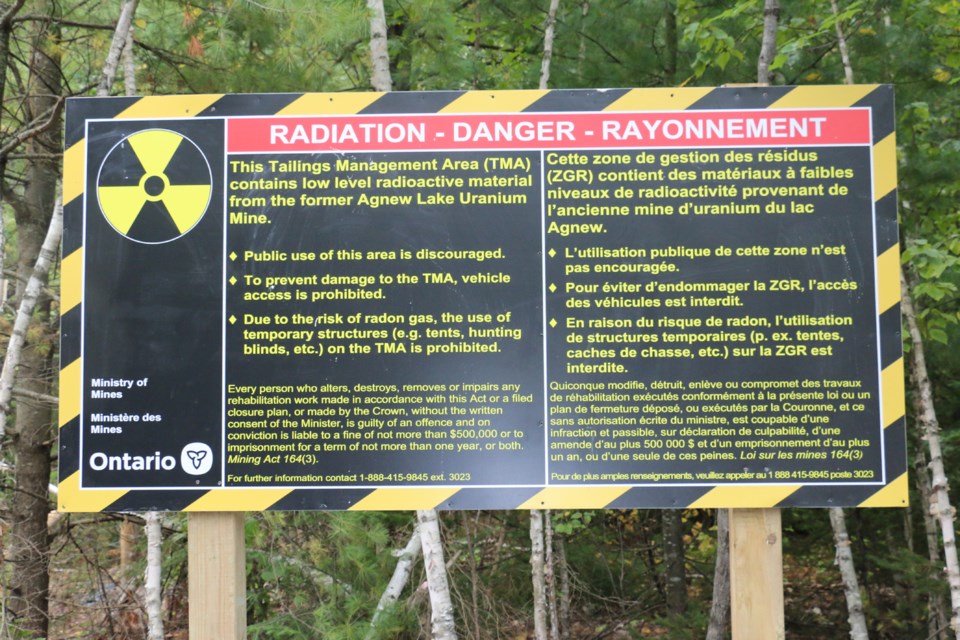The Township of Nairn and Hyman, just west of Sudbury, has filed a formal submission with the Canadian Nuclear Safety Commission (CNSC) seeking detailed answers on the maintenance of the Agnew Lake Tailings Management Area (TMA).
This follows inquiries that arose earlier this year when it was revealed there was a plan to ship low-level, naturally occurring radioactive material to the Agnew Lake TMA just north of Nairn Centre.
It was learned last summer that the Ontario Ministry of Transportation had taken on the project to remove several thousand tonnes of old niobium tailings and gravel materials from the Nipissing First Nation near North Bay, to be shipped to the Agnew Lake tailings area.
The municipality quickly called public meetings hoping to get answers and explanations.

While the plan to ship niobium is a separate issue, the Ontario Ministry of Mines revealed in September that dumping several hundred tons of niobium waste would be a suitable fix for the remediation of the Agnew Lake site, which was created in the 1990s.
The uranium tailings were dumped there when the former Agnew Lake uranium mine ceased operations in the mid-80s. Ownership of the Agnew Lake TMA was passed to the Ontario government.
The tailings were radioactive and contained uranium, lead, thorium and polonium.
It was revealed at public meetings in September that the ground cover at Agnew Lake has deteriorated over the years. There are areas where the tailings are exposed and that measurable radiation levels have been detected in the environment.
Since that information was publicized in September, access to the Agnew Lake site has been fenced off and the road is barricaded.
The township submission, a 20-page document, said this approach does not inspire confidence.
"While the Ministry of Mines has assured us that niobium tailings will improve site conditions by providing additional radiation shielding, the lack of transparency surrounding this project undermines confidence in these claims,” the township document states. “Key documents, including environmental monitoring reports, environmental risk assessments, and formal engineering plans for the site were promised to be provided to the Township in 2024, however, to date these have not been forthcoming."
The township is now suggesting the CNSC implement a new plan of action that takes in five recommendations for Agnew Lake:
- Comprehensive Site Assessment: The Agnew Lake TMA requires a full environmental assessment to evaluate the extent of contamination in both surface water and groundwater systems. This assessment should include detailed mapping of contaminant plumes and identification of all potential pathways leading to drinking water sources.
- Suspend the niobium transport plan: Recommend that the CNSC conduct a full review of the proposed niobium tailings relocation project, including its environmental and health impacts, and suspend the project until all community concerns are addressed. The report further said it is unclear whether the transportation of niobium poses any threat to the environment.
- Use clean materials at Agnew Lake: Urge CNSC and the Ministry of Mines to reconsider the use of niobium tailings as part of the site's remediation strategy. Instead, clean, inert materials should be employed to improve site conditions and restore ecological balance without introducing additional contaminants.
- Enhanced Monitoring and Maintenance: A robust monitoring program must be established, with more frequent sampling at a greater number of locations. The program should include all contaminants of potential concern (CoPCs) and address the current gaps in groundwater and surface water monitoring.
- Increased Transparency and Community Engagement: The lack of accessible technical documents undermines public trust. We are requesting that all relevant documents, including risk assessments, monitoring data, and inspection reports, should be made public in an accessible format.
Len Gillis covers health care and mining for Sudbury.com.
